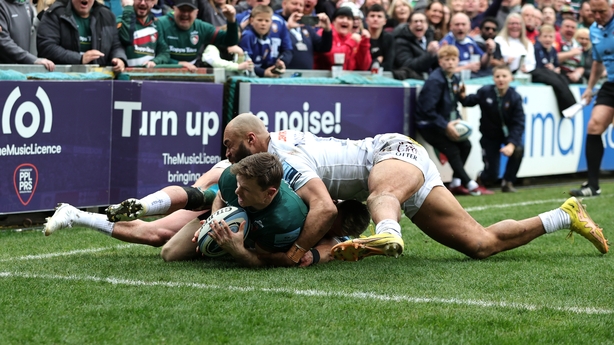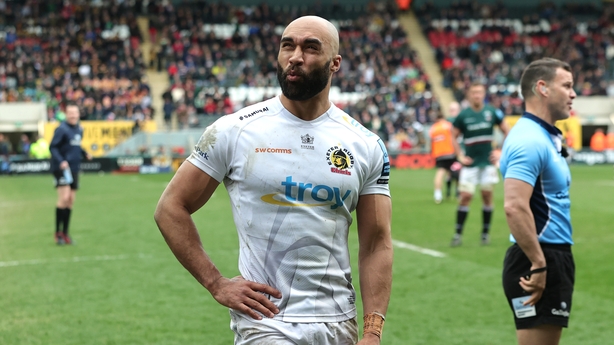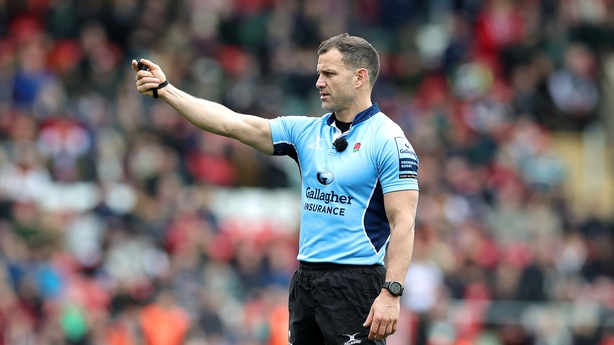Another weekend, another round of controversial refereeing decisions.
Referee Karl Dickson has found himself in the spotlight before around his perceived lax approach to head contact.
On Sunday he took charge of the Gallagher Premiership clash between Leicester Tigers and Exeter, where his decision to issue a second yellow card to Chiefs winger Olly Woodburn in trying to stop Chris Ashton in the act of scoring caused headlines.
Ashton was racing into the right-hand corner while being tackled by Stuart Hogg, with Woodburn sliding in to add his weight to the equation to force both Hogg and Ashton towards the sideline, and/or try to get under the ball to force a goal line drop-out while preventing the try.
In this instance, Dickson has been absolutely spot on with the laws as they are written.

There are two possible laws that come into play when an act of preventing a try scoring opportunity is stopped like this.
Law 13.4 states that "players on their feet and without the ball must not fall on or over players who have the ball or who are near it".
The sanction is a penalty unless it is in the act of scoring a definite try.
In this case, Woodburn has gone to ground willingly to prevent the try from being scored. However, in his defence, he didn’t go in recklessly and he didn’t attempt to make a tackle. He slid along the ground with the tackle to attempt to play the ball.
We are always asking for consistency when it comes to these decisions.
I can’t recall every decision that has been given and there are obvious examples of times where there has been no penalty given for much more sanctionable offences, but Dickson has actually penalised players for going off their feet before while attempting to make the tackle.

Maybe it’s a law that he is particularly strong on when refereeing.
There’s an example from when Ireland played Wales and Andrew Porter slid along on his knee to make a low tackle on Josh Adams. There was nothing malicious about it and if Dickson hadn’t given the penalty that day at the Millennium Stadium, I don’t think anyone would have questioned it.
That doesn’t mean that Dickson wasn’t right to call it by the letter of the law.
Although Woodburn wasn’t in any way dangerous with his entry, you can’t definitively say it wasn’t an attempted tackle assist. He made no dangerous contact with Ashton before hitting the ground, but he did assist in forcing Ashton towards the right hand touch line.
Why didn't common sense prevail when there was no danger in Woodburn’s attempt to stop the try?
You could argue that the Chiefs winger was attempting to play the ball and it wasn’t a tackle assist at all, but you’d still fall foul of the laws.
Law 14.8 states that players must remain on their feet when they play the ball and also players must "not play the ball or attempt to tackle an opponent while on the ground near the tackle".
Whether Woodburn was attempting to assist the tackle or attempting to affect the ball, there are two laws stating that he is wrong to do so.
What about common sense? Why didn’t that prevail when there was no danger in Woodburn’s attempt to stop the try?

Common sense keeps the game flowing and there will always be a judgement call from referees to make the game a better spectacle or to keep the flow of the game with fairness and consistency for both sides.
However, using common sense instead of applying the laws as they are written is exactly why there are grey areas within these decisions.
If this law was refereed as it should be more frequently, then maybe this wouldn’t be a controversial decision at all.
This decision is an outlier because it was called correctly.
Dickson is not responsible for where the incident happened or whether the offending player has already received a yellow card. The referee in this case is a victim of circumstance and can’t be blamed for the facts of the matter.
Conversely, the law doesn’t seem fit for purpose in this instance.
If a sliding player cannot be tackled, then how do you stop a player diving towards the line while in possession of the ball?
Particularly on a wet day when players can slide in from five metres or more if they are given a clear run at the line with the pace of a winger to gather momentum in the direction of the try line.
Allowing a leniency in these laws when it comes to try line defence is probably the answer to the problem, once there isn’t a dangerous action. There are other laws that don’t apply when a player is in the act of scoring a try.
For example, jumping into a tackle and jumping or diving for the try line while being tackled are the same action. It is allowed when a player is in a realistic position to score a try but not when you are further out the pitch.
The difficulty for the referee in this instance is that the sanctionable act stopped a try being scored.
If he deems that the try would have been scored without the action of Woodburn then he must award a penalty try.
If there is an illegal act stopping a try leading to a penalty try then the referee must award a yellow card.
He may not have wanted that to happen, but his hands were tied by the letter of the law once he made the initial decision.
It's much easier to take the emotion out of the refereeing decision when the controversial moment doesn’t involve a team that you support. When the decision is made without emotion, you can see how the referee is stuck between a rock and a hard place.
Grey areas will always exist in the law book and instances like this are responsible for any changes that might be made, or at least the revision of older wording within the framework of the laws.
Whether you played the game or not, or whether Dickson played the game or not is completely irrelevant.
The laws exist regardless of who is enforcing them and if there is a criticism to be made as a result of the decision at the weekend then maybe it is the law makers and not the referees who should be in the firing line.


